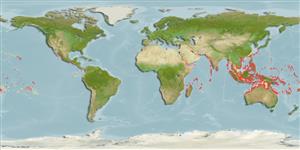Common names from other countries
>
Holocentriformes (Squirrelfishes, soldierfishes) >
Holocentridae (Squirrelfishes, soldierfishes) > Myripristinae
Etymology: Myripristis: Greek, myros, -ou = male of morey eel + Greek, pristis = saw (Ref. 45335).
More on author: Lacepède.
Environment: milieu / climate zone / depth range / distribution range
Ecología
marino asociado a arrecife; rango de profundidad 3 - 40 m (Ref. 90102). Tropical; 30°N - 24°S
Indo-Pacific: East Africa to Samoa, north to the Ryukyu Islands, south to the Great Barrier Reef and New Caledonia. Palau in Micronesia (Ref. 1602). It has not been found on low islands or atolls of the Indo-Pacific.
Tamaño / Peso / Age
Maturity: Lm ? range ? - ? cm
Max length : 30.0 cm TL macho / no sexado; (Ref. 5213)
Espinas dorsales (total) : 11; Radios blandos dorsales (total) : 13 - 15; Espinas anales: 4; Radios blandos anales: 11 - 14.
Inhabits sheltered coastal and offshore reefs, usually in turbid areas of bays and lagoons, in 3-40 m (Ref 90102). A nocturnal fish hiding in caves or beneath ledges by day, feeding on plankton such as crab larvae at night. Found in loose aggregations in caves, sometimes with other soldierfish (Ref. 9710).
Life cycle and mating behavior
Maturities | Reproducción | Spawnings | Egg(s) | Fecundities | Larva
Randall, J.E. and D.W. Greenfield, 1996. Revision of the Indo-Pacific holocentrid fishes of the genus Myripristis, with descriptions of three new species. Indo-Pac. Fish. (25):61 p. (Ref. 12419)
IUCN Red List Status (Ref. 130435)
CITES (Ref. 128078)
Not Evaluated
Threat to humans
Harmless
Human uses
Pesquerías: escaso valor comercial
Herramientas
Special reports
Download XML
Fuentes de Internet
Estimates based on models
Preferred temperature (Ref.
115969): 24.9 - 29, mean 28 (based on 846 cells).
Phylogenetic diversity index (Ref.
82804): PD
50 = 0.5000 [Uniqueness, from 0.5 = low to 2.0 = high].
Bayesian length-weight: a=0.01698 (0.01029 - 0.02803), b=3.03 (2.89 - 3.17), in cm Total Length, based on LWR estimates for this species & Genus-body shape (Ref.
93245).
Nivel trófico (Ref.
69278): 3.1 ±0.30 se; based on food items.
Resiliencia (Ref.
120179): Alto, población duplicada en un tiempo mínimo inferior a 15 meses (Preliminary K or Fecundity.).
Fishing Vulnerability (Ref.
59153): Low vulnerability (20 of 100).
